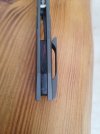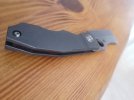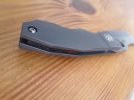- Joined
- Jan 16, 2017
- Messages
- 350
Hello,
My question is not directly knife-making related, but the thread looks appropriate, let me know if this is not the place.
I am planning on making some folder accessories from CF (clips/backspacers/scales), but before spending my money on a mill bit and a steadier collet i would appreciate any input from experienced members.
My main goal here is to get the CF scales to the desired thickness, and not any fancy machining. After that, i will shape & finish the part using a small belt grinder, a dremel and hand tools.
I'll be using my bench drill (i know it's not the tool for the job, but let's leave this out for now as i can't afford a mill at the moment) which goes up to 2450 rpm.
Apparently, that's quite low for CF, but i've read that it should be enough if i'll be using a larger bit (0.4/0.5").
Also, do you think i could use a router with a carbide flash trim to get the CF to the shape of an existing scale?
In this case i would be using an actual router so no problem on the rpm, here. You think the CF would respond well to the carbide bit?
Any thoughts/suggestions on the processes i have described would be greatly appreciated!
My question is not directly knife-making related, but the thread looks appropriate, let me know if this is not the place.
I am planning on making some folder accessories from CF (clips/backspacers/scales), but before spending my money on a mill bit and a steadier collet i would appreciate any input from experienced members.
My main goal here is to get the CF scales to the desired thickness, and not any fancy machining. After that, i will shape & finish the part using a small belt grinder, a dremel and hand tools.
I'll be using my bench drill (i know it's not the tool for the job, but let's leave this out for now as i can't afford a mill at the moment) which goes up to 2450 rpm.
Apparently, that's quite low for CF, but i've read that it should be enough if i'll be using a larger bit (0.4/0.5").
Also, do you think i could use a router with a carbide flash trim to get the CF to the shape of an existing scale?
In this case i would be using an actual router so no problem on the rpm, here. You think the CF would respond well to the carbide bit?
Any thoughts/suggestions on the processes i have described would be greatly appreciated!




